
The endangered American burying beetle (Nicrophorus americanus), once widespread over temperate eastern North America, is now known from only a few isolated locations. A member of the carrion beetle family, this species is noted for the unique manner it exploits prey.
Adult males, from distances of two miles, detect the faintest odor of recently dead small mammals and birds. A male and a female beetle quickly fly to claim the find, and overnight excavate a grave to bury the found carcass. With interment complete by morning, and the carcass protected from other scavengers, females lay eggs in the decaying flesh, which soon provides food for the developing larvae.
On the federal endangered species list since 1989, reduced reproductive success of this species is an important factor greatly reducing the distribution of this species. Over time, habitat fragmentation has resulted in large decreases in populations of small mammals and birds, carcasses of which are necessary for success of this very interesting insect.
Specimens of the American burying beetle are part of ALMNH’s Löding Beetle Collection, amassed by Mr. Henry P. Löding from 1900 to 1930. Löding collected extensively throughout Alabama, but especially around his hometown, Mobile.
The Entomology Collection is home to several historically significant collections, including the H.P. Löding Beetle Collection and the R.L. Chermock Butterfly Collection. Additionally, it is one of the largest aquatic insect collections in the southeastern United States. The collection is housed in the Mary Harmon Bryant Collections Facility.
Dr. G. Milton Ward, emeritus professor and curator of insects for the Alabama Museum of Natural History, provided the above information.
